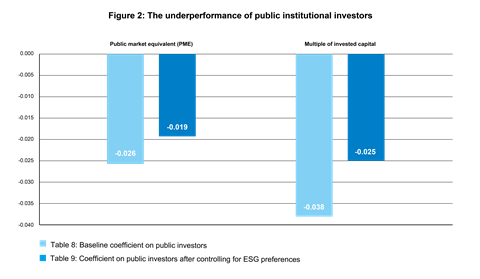By Aleksandar Andonov, University of Amsterdam and CEPR; Roman Kräussl, University of Luxembourg and Hoover Institution, Stanford University; Joshua Rauh, Stanford Graduate School of Business, Hoover Institution, and NBER.
Despite delivering weak performance and failing to match the characteristics typically attributed to infrastructure investments – such as withstanding swings in the business cycle, having little correlation with equity markets, and delivering long-lasting, inflation-linked cash flows – closed-end private infrastructure funds increased their assets under management from US$59 billion in 2008 to US$486 billion in 2019.
In our paper, we explore the reasons behind this growth, and find that public institutional investors motivated by environmental, social and governance (ESG) considerations are driving a significant amount of interest in the asset class.
Although infrastructure investments can generate societal benefits, public investors perform worse than private investors – indicating that there is potentially a price to pay for pursuing investments driven by ESG considerations.
ESG considerations driving infrastructure investments
In our analysis, we collect data on investments in private infrastructure funds made by six types of institutional investors. Three types belong to the public sector: public pension funds, government agencies, and sovereign wealth funds, while the other three types belong to the private sector: private pension funds, insurance firms and banks, and university endowments and foundations.
We find that the growth of infrastructure as an asset class is driven by increased allocations from public institutional investors over time. Figure 1 shows that private investors accounted for a relatively larger share of the infrastructure deals and fund commitments in the past, but their share is declining, while the share of public investors has increased from 22% in 2001 to 55% in 2020.

We document that, on average, public investors make 0.31 more investments in closed-end infrastructure funds per year than private investors of similar size and experience. We examine whether the expected social externalities of infrastructure assets drive this increase in allocations by public investors. Since infrastructure assets have the potential to offer environmental, social, and political benefits, public institutional investors with strong ESG preferences or subject to regulatory pressure may be willing to invest more in them.
Using a list of Principles for Responsible Investment (PRI) signatories as a proxy for institutional investors that have strong ESG preferences, we find this is indeed the case. PRI signatories make 0.39 more investments in infrastructure funds per year than investors that are not signatories. This difference in the number of investments is entirely driven by public institutional investors that are PRI signatories – they make 0.76 more infrastructure investments per year compared to investors that are not signatories.
We also use the PRI’s regulation database to distinguish between investors that face mandatory regulations requiring them to consider ESG factors in their investment decisions, investors that operate under voluntary regulations such as suggested standards of good practice or ESG recommendations, and investors that are not subject to any ESG regulations. We find that institutional investors respond to ESG regulation by increasing their allocation to infrastructure. Mandatory ESG regulations have a similar positive impact on the number of investments made by public and private institutional investors. However, only public investors seem to (proactively) increase their infrastructure investments in response to voluntary ESG regulations.
Overall, controlling for PRI signatories, mandatory and voluntary ESG regulations explains 25% – 40% of the higher number of infrastructure investments made by public investors. The effect of ESG preferences and regulatory pressure on infrastructure investments is likely to continue in the coming years as the number of investors becoming signatories to the PRI (or similar initiatives) is increasing and there are many regulatory initiatives expanding the responsibilities of institutional investors regarding sustainable investments and climate change.
How do public investors perform in infrastructure relative to private investors?
Public institutional investors receive lower performance from their infrastructure investments than private institutional investors. Figure 2 shows that public investors receive a 0.026 lower public market equivalent (PME) and a 0.038 lower multiple of invested capital than private investors (where the average PME of infrastructure funds is 0.93 and the average multiple is 1.34). This disparity in performance does not seem to be due to differences in risk taking, as we control for underlying deal characteristics such as project stage (greenfield, brownfield, secondary), region, home (local) deals, concession agreement, and industry (e.g., renewable energy, traditional energy, social, transport, and utilities).
The underperformance of public investors is at least partially driven by the social externalities of infrastructure assets, as public institutional investors with ESG considerations invest more in infrastructure over time. We find that PRI signatories invest in infrastructure funds that deliver a 0.028 lower PME and a 0.042 lower multiple. Investments in infrastructure impact funds also underperform by 0.175 PME points and 0.363 multiple points. Figure 2 shows that controlling for PRI signatories and impact funds explains approximately 30% of the underperformance of public institutional investors, as the performance differential between public and private investors diminishes from -0.026 to -0.019 lower PME.

The explanatory power of these two proxies for ESG preferences is not due to exposure to assets in different regions or industries. Our results do not imply that PRI signatories and impact investors underperform because they invest in renewable energy or emerging economies, but rather that their underperformance is due to investing in marginal deals within these industries or regions that have a lower financial return and have not received funding from traditional infrastructure funds. The PRI signatories variable explains part of this underperformance because public investors that are PRI signatories make more infrastructure investments. Thus, public investors that are PRI signatories underperform since they commit capital not only to deals with strong financial potential, but also to more marginal deals with weaker financial potential. Similarly, controlling for impact funds explain part of the underperformance of public investors because they have more exposure to these funds, not because they pick impact funds that perform particularly badly.
Implications for infrastructure investments
Our findings have important implications as public institutional investors continue to increase their actual infrastructure allocations and portfolio targets. For example, in 2019, the Employees Retirement System of Texas reported a target allocation to infrastructure of 7%, compared to an actual allocation of 2.9%, while the Norwegian Government Pension Fund received government approval to start investing up to 2% (around US$20 billion) in renewable energy infrastructure.
We find that the differences in performance between public and private institutional investors are in part attributable to their differences in adopting non-financial objectives. ESG preferences and regulation explain 25% - 40% of the higher number of infrastructure investments made by public investors and around 30% of their underperformance. Non-financial objectives and social externalities are especially relevant for infrastructure because these assets are closely related to government spending and regulation but managed by profit-maximising intermediaries.
While infrastructure investments could obviously have societal benefits, the underperformance of public institutional investors reflects a price that is paid to create these benefits, with the value transfers going either to the infrastructure assets or to the general partners managing private infrastructure funds through fees. We estimate the annual dollar value of these transfers to be around US$5 billion.
Consideration of ESG factors throughout the investment process and project lifecycle is essential to the success of infrastructure investment. At the same time, investing in infrastructure provides institutional investors with access to opportunities that will underpin the transition to a greener, more just, global economy. The PRI has a range of resources to support infrastructure investors, including:
This blog is written by academic guest contributors. Our goal is to contribute to the broader debate around topical issues and to help showcase research in support of our signatories and the wider community.
Please note that although you can expect to find some posts here that broadly accord with the PRI’s official views, the blog authors write in their individual capacity and there is no “house view”. Nor do the views and opinions expressed on this blog constitute financial or other professional advice.
If you have any questions, please contact us at [email protected]












